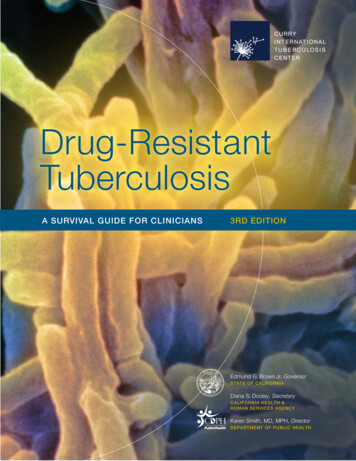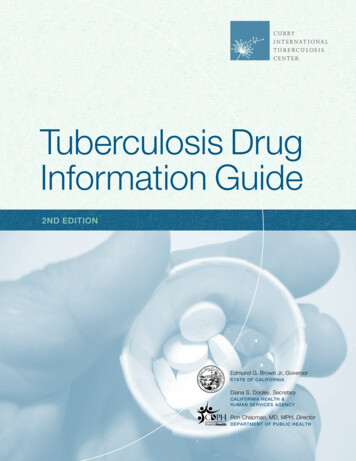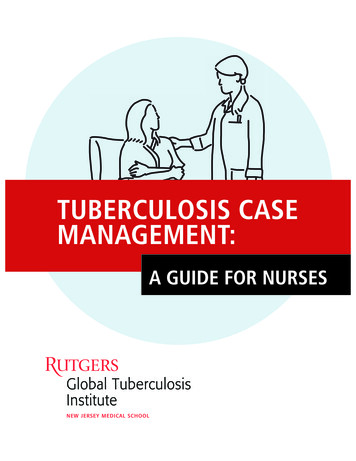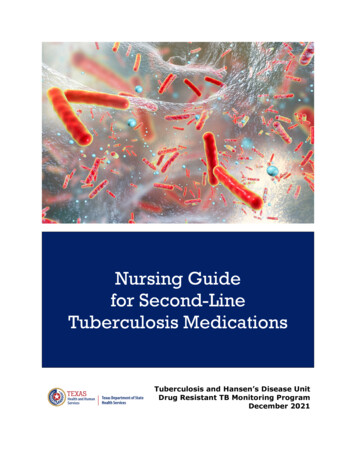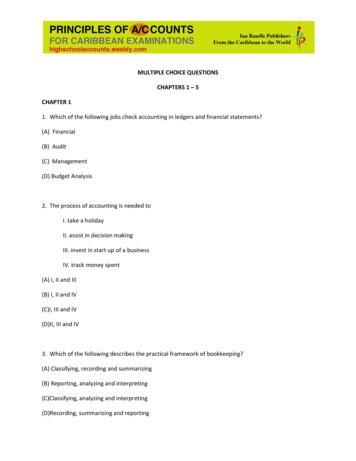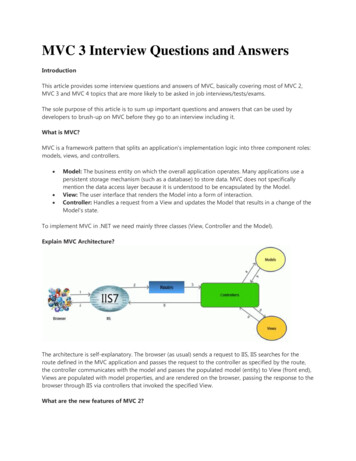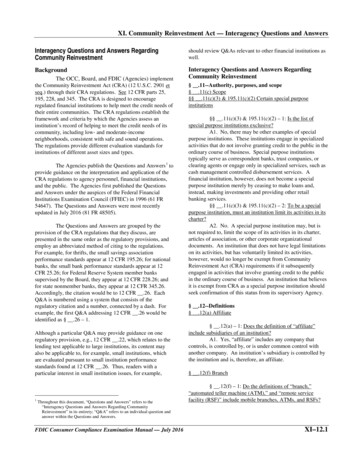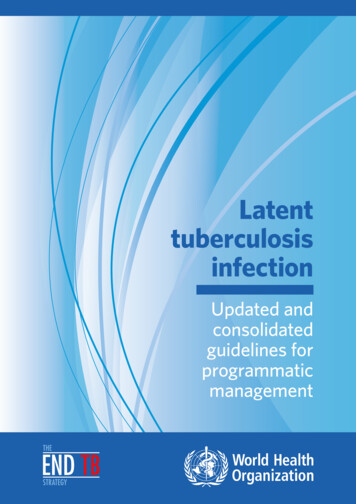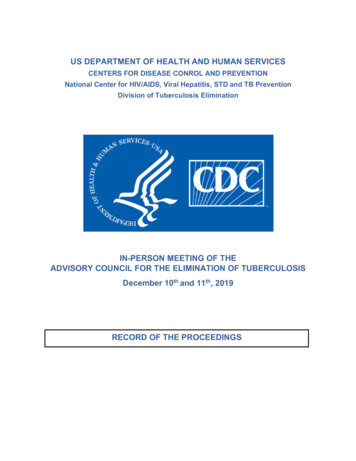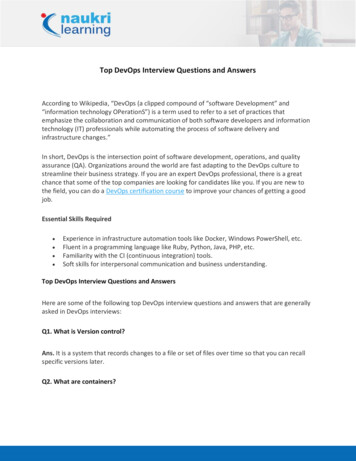
Transcription
QUESTIONSAND ANSWERSABOUTTUBERCULOSIS2021
UESTIONS&NSWERSABOUTTUBERCULOSIS2021Questions and Answers About Tuberculosis (TB) provides informationon the diagnosis and treatment of TB infection and TB disease. Keyaudiences for this booklet are people with or at risk for TB; peoplewho may have been exposed to someone with TB; people whoprovide services for those at high risk for TB, such as correctionalofficers, homeless shelter workers, and emergency responders; andpeople who want to learn more about tuberculosis. For additionalinformation on TB, please visit the CDC TB website.U.S. DEPARTMENT OF HEALTH AND HUMAN SERVICESCenters for Disease Control and PreventionNational Center for HIV/AIDS, Viral Hepatitis, STD, and TB PreventionDivision of Tuberculosis Elimination
TABLE OF CONTENTSWhat is TB? . . . . . . . . . . . . . . . . . . . . . . . . . . . . . . . . . . . . . . . . . . . . . . . . . . . . . . . . . . . . . . . . . . . . 4Why is TB still a problem in the United States? . . . . . . . . . . . . . . . . . . . . . . . . . . . . . . . . . . . . 4How is TB spread? . . . . . . . . . . . . . . . . . . . . . . . . . . . . . . . . . . . . . . . . . . . . . . . . . . . . . . . . . . . . . . 4Who is at risk for getting TB? . . . . . . . . . . . . . . . . . . . . . . . . . . . . . . . . . . . . . . . . . . . . . . . . . . . . 5What is latent TB infection (LTBI)? . . . . . . . . . . . . . . . . . . . . . . . . . . . . . . . . . . . . . . . . . . . . . . . 5What is TB disease? . . . . . . . . . . . . . . . . . . . . . . . . . . . . . . . . . . . . . . . . . . . . . . . . . . . . . . . . . . . . 6Who is at risk for TB disease? . . . . . . . . . . . . . . . . . . . . . . . . . . . . . . . . . . . . . . . . . . . . . . . . . . . . 7What are the symptoms of TB disease? . . . . . . . . . . . . . . . . . . . . . . . . . . . . . . . . . . . . . . . . . . . 8What is the difference between latent TB infection (LTBI) and TB disease? . . . . . . . . . . . 9Should I get tested for TB? . . . . . . . . . . . . . . . . . . . . . . . . . . . . . . . . . . . . . . . . . . . . . . . . . . . . . . 10What are the tests for TB infection? . . . . . . . . . . . . . . . . . . . . . . . . . . . . . . . . . . . . . . . . . . . . . . 10What if I have a positive test for TB infection? . . . . . . . . . . . . . . . . . . . . . . . . . . . . . . . . . . . . . 12What if I have been vaccinated with bacille Calmette-Guérin (BCG)? . . . . . . . . . . . . . . . . . 12If I have latent TB infection (LTBI), how can I avoid developing TB disease? . . . . . . . . . . . 13What are the side effects of medicines to treat latent TB infection (LTBI)? . . . . . . . . . . . 14What if I have HIV infection? . . . . . . . . . . . . . . . . . . . . . . . . . . . . . . . . . . . . . . . . . . . . . . . . . . . . . 16If I was exposed to someone with TB disease, can I give TB to others? . . . . . . . . . . . . . . . 16How is TB disease treated? . . . . . . . . . . . . . . . . . . . . . . . . . . . . . . . . . . . . . . . . . . . . . . . . . . . . . . 17What are the side effects of TB disease medicines? . . . . . . . . . . . . . . . . . . . . . . . . . . . . . . . . 18Why do I need to take TB medicines for so long? . . . . . . . . . . . . . . . . . . . . . . . . . . . . . . . . . . 19What are multidrug-resistant TB (MDR TB) and extensively drug-resistant TB (XDR TB)? . 19What is directly observed therapy (DOT)? . . . . . . . . . . . . . . . . . . . . . . . . . . . . . . . . . . . . . . . 20How can I remember to take my TB medicines if I am not on DOT? . . . . . . . . . . . . . . . . . . 21How can I keep from spreading TB? . . . . . . . . . . . . . . . . . . . . . . . . . . . . . . . . . . . . . . . . . . . . . . 22Additional TB Resources . . . . . . . . . . . . . . . . . . . . . . . . . . . . . . . . . . . . . . . . . . . . . . . . . . . . . . . . 23
What is TB?Tuberculosis (TB) is caused by bacteria called Mycobacterium tuberculosis (M.tuberculosis). The bacteria, or germs, usually attack the lungs. TB germs can attackany part of the body, such as the kidney, spine, or brain.There is good news. People with TB can be treated if they seek medical help.Why is TB still a problem in the United States?TB is preventable and treatable but remains the world’s deadliest infectious-diseasekiller. Having infectious TB disease means that you can spread TB germs to others. Inthe last several years, the United States has reported the lowest number of TB caseson record, but too many people still suffer from TB. Even with decreasing numbers,TB continues to be a problem. While the number of TB cases in the United Stateshas gone down, TB rates are still higher among persons in racial and ethnic minoritygroups compared with White persons. This is because certain racial and ethnic groupsare more likely to have TB risk factors that can increase the chance of developing thedisease (see page 7).This booklet answers common questions about TB. Please ask your doctor, nurse, orother health care provider if you have additional questions.How is TB spread?TB is spread through the air from one person to another. The TB germs are spread intothe air when a person with infectious TB disease of the lungs or throat coughs, speaks,or sings. People nearby may breathe in these TB germs and become infected.When a person breathes inTB germs, the TB germscan settle in the lungsand begin to grow. Fromthere, the TB germs canmove through the bloodto other parts of thebody, such as thekidney, spine,or brain.Q&A ABOUT TB4
Who is at risk for getting TB?Anyone can get TB. Some people have a higher risk of getting infected with TB:People who have contact with someone who has infectious TB diseasePeople who were born in or who frequently travel to countries where TB diseaseis common, including Mexico, the Philippines, Vietnam, India, China, Haiti,Guatemala, and other countries with high rates of TBHealth care workers and others who work or live in places at high risk for TBtransmission, such as homeless shelters, jails, and nursing homesWhat is latent TB infection (LTBI)?In most people who breathe in TB germs and become infected, the body is able tofight the TB germs to stop them from growing. The TB germs become inactive, butthey remain alive in the body and can become active later. This is called latent TBinfection, or LTBI for short.People with LTBIHave no symptoms.Don’t feel sick.Can’t spread TB germs to others.Will usually have a positive TB blood test or positive TB skin test reaction.May develop TB disease if they do not receive treatment for LTBI (see page 13).People with LTBI do not have symptoms, and they cannot spread TB germs to others.However, if TB germs become active in the body and multiply, the person will go fromhaving LTBI to being sick with TB disease. For this reason, people with LTBI should betreated to prevent them from developing TB disease. Treatment of LTBI is essential tocontrolling TB in the United States because it substantially reduces the risk that LTBIwill progress to TB disease.Q&A ABOUT TB5
What is TB disease?If the immune system can’t stop TB germs from growing, the TB germs begin tomultiply in the body and cause TB disease. The TB germs attack the body, and if thisoccurs in the lungs, the TB germs can create a hole in the lung. Some people developTB disease soon after becoming infected (within weeks) before their immune systemcan fight the TB germs. Other people have latent TB infection and may get sick yearslater, when their immune system becomes weak for another reason. Treating latent TBinfection (LTBI) is effective in preventing TB disease.People with TB disease in the lungs or throat can be infectious, meaning that they canpass TB germs to their family, friends, and others around them. People with TB in otherparts of their bodies, such as the kidneys or spine, are usually not infectious.People with TB disease are most likely to spread TB germs to people they spend timewith every day. This includes family members, friends, coworkers, or schoolmates.People with TB disease need to take several medicines when they start treatment.After taking TB medicine for several weeks, a doctor will be able to tell TB patientswhen they are no longer able to spread TB germs to others. Most people with TBdisease will need to take TB medicine for at least 6 months to be cured.Q&A ABOUT TB6
Who is at risk for TB disease?Many people who have latent TB infection (LTBI) never develop TB disease. Whilenot everyone with LTBI will develop TB disease, about 5–10% will develop TB diseaseover their lifetimes if not treated. Progression from untreated LTBI to TB disease isestimated to account for approximately 80% of U.S. TB cases. Some people whohave LTBI are more likely to develop TB disease than others. People at high risk fordeveloping TB disease generally fall into two categories:1.Those who have been recently infected with TB germs2.Those with medical conditions that weaken the immune system including:HIV infectionSubstance use (such as injection drug use)Specialized treatment for rheumatoid arthritis or Crohn’s diseaseOrgan transplantsSevere kidney diseaseHead and neck cancerDiabetesMedical treatments such as corticosteroidsSilicosisLow body weightChildren, especially those under age 5, have a higher risk of developing TB diseaseonce infected.Q&A ABOUT TB7
What are the symptoms of TB disease?Symptoms of TB disease depend on where in the body the TB germs are growing. TBdisease in the lungs may cause the following symptoms:» Cough(lasting longerthan 3 weeks)Coughing up blood orsputum (phlegm frominside the lungs)» Chest pain» Fever» Night sweats» Chills» Loss of appetite» Weakness or fatigue» Weight lossSymptoms of TB disease in other parts of the body may include the following:TB of the kidney may cause blood in the urine.TB meningitis may cause headache or confusion.TB of the spine may cause back pain.TB of the larynx may cause hoarseness.For information on how TB disease is treated, see page 17.Q&A ABOUT TB8
What is the difference between latent TB infection(LTBI) and TB disease?There are important differences between latent TB infection (LTBI) and TB disease.Knowing the differences can help you understand what to expect if you have LTBI orTB disease. The table below explains these key differences side by side.TBTBTBA Person with LatentTB Infection (LTBI)TBTBTB TBTB TBTB TBTB TBTBTBTBTB TBTBTB TBTBTB TBTBTBA Person withTB DiseaseHas a small amount of TB germs in his/her body that are alive but inactiveHas a large amount of active TB germsin his/her bodyHas no symptomsHas symptoms that may includea bad cough that lasts 3 weeks orlongerpain in the chestcoughing up blood or sputumweakness or fatigueweight lossno appetitechillsfeversweating at nightCannot spread TB germs to othersMay spread TB germs to othersDoes not feel sickMay feel sick and may have symptomssuch as a cough, fever, and/or weightlossUsually has a positive TB skin test or TBblood test indicating TB infectionUsually has a positive TB skin test or TBblood test indicating TB infectionHas a normal chest x-ray and a negativesputum smearMay have an abnormal chest x-ray, orpositive sputum smear or cultureShould consider treatment for LTBI toprevent TB diseaseNeeds treatment for TB diseaseQ&A ABOUT TB9
Should I get tested for TB?You should get tested for TB if:You have spent time with a person known or thought to have infectious TBdisease.You were born in or frequently travel to countries where TB disease is common,including Mexico, the Philippines, Vietnam, India, China, Haiti, and Guatemala, andother countries where TB is common.You currently live, used to live, or are employed in a large group setting where TBis more common, such as a homeless shelter, prison, jail, or nursing home.You are a health care worker who cares for patients with TB disease.You are part of a population that is more likely to have latent TB infection (LTBI)or TB disease, including people who don’t have good access to health care, havelower income, or misuse drugs or alcohol.In addition, children, especially those under 5, have a higher risk of developing TBdisease once infected. Therefore, testing for TB infection in children who may havebeen exposed to a person with TB disease is important.What are the tests for TB infection?There are two types of tests for TB infection: the TB blood test and the TB skin test.Your health care provider should choose which TB test to use. Factors in selectingwhich test to use include the reason for testing, test availability, and cost. Health careproviders are encouraged to use newer TB blood tests to screen for TB infection.Generally, it is not necessary to use both a TB skin test and a TB blood test to test thesame person.TB Blood TestsTB blood tests use a blood sample to find out if you are infected with TB germs.Two TB blood tests are approved by the U.S. Food and Drug Administration and areavailable in the United States:QuantiFERON -TB Gold Plus (QFT-Plus)T-SPOT .TB test (T-Spot)Q&A ABOUT TB10
You can get a TB blood test at the health department or at your doctor’s office. Thehealth care provider will draw your blood and send it to a laboratory for analysis andresults. If your health department uses a TB blood test, only one visit is required todraw blood for the test. -Positive TB blood test: This means that you have been infected with TBgerms. Additional tests are necessary to determine whether you havelatent TB infect (LTBI) or TB disease.Negative TB blood test: This means that your blood did not react to thetest and that you likely do not have TB infection.TB blood tests are the recommended TB test for:People who have received the bacille Calmette–Guérin (BCG) TB vaccine.People who have a difficult time returning for a second appointment to look for areaction to the TB skin test.TB Skin TestThe TB skin test may be used to find out if you are infected with TB germs. You canget a skin test at the health department or at your doctor’s office. A health care workerwill inject a small amount of testing fluid (called tuberculin or PPD) into the skin on thelower part of your arm. After 2 or 3 days, you must return to have your skin test readby the health care worker. You may have swelling where the tuberculin was injected.The health care worker will measure this swelling and tell you if your reaction to thetest is positive or negative. -Positive skin test: This means the person’s body is infected with TBgerms. Additional tests are needed to determine if the person has LTBI orTB disease.Negative skin test: This means the person’s body did not react to the test,and that LTBI or TB disease is not likely.If your exposure to TB germs was recent, your TB skin test reaction may not bepositive yet. You may need a second skin test 8 to 10 weeks after the last time youspent time with the person with TB disease. This is because it can take several weeksafter infection for your immune system to react to the TB skin test. If your reaction tothe second test is negative, you probably do not have TB infection.Q&A ABOUT TB11
What if I have a positive test for TB infection?If you have a positive reaction to the TB blood test or TB skin test, your doctor ornurse will do other tests to see if you have TB disease. These tests usually include achest x-ray. They may also include a test of the sputum you cough up. Because TBgerms may be found somewhere other than your lungs, your doctor or nurse maycheck your urine, take tissue samples, or do other tests. Without treatment, latent TBinfection (LTBI) can progress to TB disease. If you have LTBI, you should be treatedto prevent TB disease (see page 13). If you have TB disease, you will need to takemedicine to treat the disease (see page 17).What if I have been vaccinated with bacille CalmetteGuérin (BCG)?BCG is a vaccine for TB. This vaccine is not widely used in the United States. Manypeople born outside of the United States have received the BCG TB vaccine.It is often given to infants and small children in other countries where TB is morecommon. It protects children in those countries from getting severe forms of TBdisease, such as TB meningitis. The BCG TB vaccine is not thought to protect peoplefrom getting TB disease in the lungs, which is the most common form of disease in theUnited States.In some people, BCG TB vaccine may cause a positive TB skin test when they arenot infected with TB germs. However, there is no way to know if a positive skin testreaction is caused by BCG vaccination or caused by true TB infection.When using the skin test, people who have been vaccinated with BCGand who have a positive skin test reaction should always be furtherevaluated for TB disease as if they were not vaccinated with BCG.Unlike the TB skin test, TB blood tests are not affected byprior BCG vaccination. Therefore, TB blood tests are thepreferred test for people who have received the BCGvaccine.BCGQ&A ABOUT TB12
If I have latent TB infection (LTBI), how can I avoiddeveloping TB disease?Without treatment, latent TB infection (LTBI) can progress to TB disease. If youhave LTBI, you should be treated to prevent TB disease even if you do not feel sick.Treatment of LTBI is essential to preventing TB because it substantially reduces therisk that LTBI will progress to TB disease.Treating LTBI is effective in preventing TB disease. There are several options forthe treatment of LTBI. There have been advances in shortening the length of LTBItreatment from 6–9 months to 3–4 months. Short-course LTBI treatments are effective,are safe, and have higher completion rates than longer treatments.If you have LTBI and you are in a high-risk group (see page 7), it is even more urgentthat you take medicine, so you don’t develop TB disease. The following TB medicationsare used on their own or in combination to treat LTBI:Isoniazid (INH)Rifapentine (RPT)Rifampin (RIF)CDC and the National Tuberculosis Controllers Association recommend one of thefollowing treatment options for LTBI:Three months of once-weekly isoniazid plus rifapentine (3HP)Four months of daily rifampin (4R)Three months of daily isoniazid plus rifampin (3HR)If none of the treatment regimens above is an option for you, there are alternativeeffective LTBI treatment regimens which include 6 or 9 months of isoniazid. Whentaking isoniazid, your doctor may have you take vitamin B6 with your medication.Your doctor will be able to determine which treatment option is best for yoursituation. Your treatment may have to be modified if you have had contact withsomeone whose TB disease is caused by germs that are resistant to isoniazid orrifampin, two of the most important medicines for treating LTBI and TB disease. Thismeans that those medicines can no longer kill the TB germs.Sometimes people are given treatment for LTBI even if their TB blood test result or TBskin test reaction is negative. This is often done with infants, children, and HIV-infectedpeople who have recently spent time with someone with TB disease. This is becausethese groups are at very high risk of developing TB disease soon after they becomeinfected with TB germs.Q&A ABOUT TB13
If you start taking treatment for LTBI, you will need to see your doctor or nurse ona regular schedule. It is important that you take all the medicine as prescribed. Thedoctor or nurse will check on how you are doing.What are the side effects of medicines to treat latentTB infection (LTBI)?Most people can take their latent TB infection (LTBI) medicines without any problems;however, sometimes there are side effects. Some side effects are minor problems. Forexample, the rifampin or rifapentine medicine may cause orange discoloration of bodyfluids such as urine (pee), saliva, tears, or sweat, and breast milk. Orange discolorationof body fluids is expected and harmless. This is normal and the color may fade overtime. The doctor or nurse may advise you not to wear soft contact lenses because theymay get permanently stained. If you have any of these side effects, you can continuetaking your medicine.If you have a serious side effect, call your doctor or nurse immediately. You may betold to stop taking your LTBI medicines or to return to the clinic for tests. Serious sideeffects include:Dizziness or lightheadednessLoss of appetiteFlu-like symptomsSevere diarrhea or light-colored stoolsShortness of breathFeelings of sadness or depressionFeverUnexplained weight lossBrown urine (color of coffee or cola)Yellowish skin or eyesRashPersistent tingling or pricklingsensation of hands and feetPersistent tiredness or weaknesslasting 3 or more daysStomach painEasy bruising or bleedingJoint painNauseaVomitingQ&A ABOUT TB14
You should provide a list of current medicines you are taking to your health careprovider to avoid drug interactions. Some oral contraceptives (birth control pills)may not work as well when you take them with TB medicines. This is because theTB medicines can sometimes interfere with birth control pills and possibly makethe birth control pills less effective. If you are using birth control pills, talk with yourdoctor before beginning any new medicines. More information on side effects from TBmedicine can be found at CDC’s TB Treatment: Adverse Events page.Warning: Drinking alcoholic beverages, such as wine, beer, or liquor, while taking TBmedicines can be dangerous. Check with your doctor or nurse for more information.Everyone who has LTBI needs to know the symptoms of TB disease (see page 8). Ifyou develop symptoms of TB disease, you should see a doctor right away.People sometimes need help managing the LTBI medicine they must take. The CDChas developed LTBI medicine trackers to help patients organize and manage their LTBImedicine. On these medicine trackers, there is space to write treatment schedules,medication intake, and doctor/clinic contact information. There is also a checklist ofsigns and symptoms that may develop while taking LTBI medicine.The three medicine trackers include:1.12-Dose Regimen forLatent TB InfectionMedication Trackerand SymptomChecklist(available in English,Spanish, Tagalog,and Vietnameselanguages).2.3.4 Months DailyRifampin (4R)Regimen forLatent TB InfectionMedication Trackerand SymptomChecklist3 Months of DailyIsoniazid plusRifampin (3HR)Regimen forLatent TB InfectionMedication Trackerand SymptomChecklist(available in English).(available in English).To download or print these materials, visit the CDC TB Education Materials page.To learn more about LTBI, visit these CDC webpages:Treatment Regimens for LTBIDeciding When to Treat LTBITreating LTBI with Short-Course RegimensQ&A ABOUT TB15
What if I have HIV infection?If you have HIV infection and latent TB infection (LTBI), you need treatment as soonas possible to prevent TB disease. A person with HIV infection who also has untreatedLTBI is much more likely to develop TB disease during his or her lifetime than someonewithout HIV infection. Among people with LTBI, HIV infection is the strongest knownrisk factor for progressing to TB disease. All people with HIV infection should betested to find out if they have LTBI and promptly seek treatment if necessary. Thereare several effective LTBI treatment regimens available for people with HIV.If I was exposed to someone with TB disease, can Igive TB to others?If you were exposed to someone with TB disease, you may become infected with TBbacteria, but you would not be able to spread the bacteria to others right away. Onlypeople with infectious TB disease can spread TB germs to others. Before you wouldbe able to spread TB germs to others, you would have to breathe in TB germs andbecome infected. Then the germs would have to multiply in your body and causeinfectious TB disease. At this point, you could possibly spread TB germs to others.In most people who breathe in TB germs and become infected, the body can fight thegerms to stop them from growing. The germs become inactive, but they remain alive inthe body and can become active later. This is called latent TB infection (LTBI). Peoplewith LTBI cannot spread TB germs to others. People who have LTBI can be treated toprevent TB disease.Q&A ABOUT TB16
How is TB disease treated?There is good news for people with TB disease! It can almost always be treated and curedwith medicine. But the medicine must be taken as directed by your doctor or nurse.If you have TB disease, you will need to take several different TB medicines. This isbecause there are many TB germs to be killed. Taking several TB medicines will do abetter job of killing all the TB germs and preventing them from becoming resistant tothe medicines. “Resistant” means that the medicine can no longer kill the TB bacteria.The most common medicines used to treat TBdisease areIsoniazid (INH)Rifampin (RIF)Ethambutol (EMB)Pyrazinamide (PZA)If you have TB disease of the lungs orthroat, you are probably infectious. Youneed to stay home from work or school sothat you don’t spread TB germs to otherpeople. After taking your medicine for a fewweeks, you will feel better and you might nolonger be infectious to others. Your doctor ornurse will tell you when you can return to work orschool or visit with friends.Having TB disease should not stop you from leading a normal life. People who are nolonger infectious or feeling sick are often able to do the same things they did beforethey had TB disease. If you take your medicines as directed by your doctor or nurse,they should kill all the TB germs. This will keep you from becoming sick again.Q&A ABOUT TB17
What are the side effects of TB disease medicines?If you are taking medicines for TB disease, you should take them as directed by yourdoctor or nurse. The TB medicines may cause side effects. Some side effects are minorproblems. Others are more serious. If you have a serious side effect, call your doctoror nurse immediately. You may be told to stop taking your TB medicines or to returnto the clinic for tests. Serious side effects include:Skin rashYellowish skin or eyesBlurred or changed visionDizzinessStomach painTingling or numbness aroundthe mouthBrown urine or light-colored stoolFever for 3 or more daysPersistent tingling sensationin the hands and feetFlu-like symptomsStomach upsetLack of appetiteJoint achesNauseaEasy bruising orbleedingTirednessVomitingSome side effects are minor problems. For example,rifampin may cause orange discoloration of bodyfluids such as urine (pee), saliva, tears, or sweat,and breast milk. Orange discoloration of bodyfluids is expected and harmless. This is normal andthe color may fade over time. The doctor or nursemay advise you not to wear soft contact lensesbecause lenses may get permanently stained. Ifyou have any of these side effects, you can continuetaking your medicine.Medicine that is prescribed to treat TB disease may interactwith other drugs. You should provide a list of current medicines you are taking to yourhealth care provider to avoid drug interactions.For example, medicine for TB disease can interact with oral contraceptives (birthcontrol pills) and possibly make the birth control pills less effective. If you are usingbirth control pills, ask your doctor about alternative birth control while you are takingTB medicines. If you are taking methadone (used to treat drug addiction) during TBtreatment, you may have withdrawal symptoms. Your doctor or nurse may need toadjust your methadone dosage.More information on side effects from TB medicine can be found at CDC’s TBTreatment: Adverse Events page.Q&A ABOUT TB18
Why do I need to take TB medicines for so long?TB germs die very slowly. For the treatment of latent TBinfection (LTBI), it takes at least 3 months (and possiblylonger depending on which medications you are on)to kill the TB germs.For TB disease, it usually takes 6 months or longerfor the medicines to kill all the TB germs. You willprobably start feeling well after only a few weeksof treatment, but beware! The TB germs are stillalive in your body, even if you feel better. You mustcontinue to take your medicines until all the TBgerms are dead, even though you may feel better andhave no more symptoms of TB disease.It can be very dangerous to stop taking your medicines or not to take all yourmedicines regularly. The TB germs will grow again, and you will remain sick for alonger time. The TB germs may also become resistant to the medicines you are taking.You may need new different medicines to kill the TB germs if the old medicines nolonger work. These new medicines must be taken for a longer time and usually havemore serious side effects.If you become infectious again, you could give TB germs to your family, friends, oranyone else who spends time with you. It is very important to take all your medicinesas directed by your doctor or nurse.What are multidrug-resistant TB (MDR TB) andextensively drug-resistant TB (XDR TB)?Sometimes the TB germs are resistant to the medicines used to treat TB disease. Thismeans that the medicine can no longer kill the TB germs.Multidrug-resistant TB (MDR TB) is caused by TB germs that are resistant to at leasttwo of the most important TB medicines: isoniazid and rifampin.A more serious form of MDR TB is called extensively drug-resistant TB (XDR TB). XDRTB is a rare type of TB that is resistant to nearly all medicines used to treat TB disease.If you do not take your medicines as directed by your doctor or nurse, the TB germsmay become resistant to certain medicines. Also, people who have spent time withsomeone who is sick with MDR TB or XDR TB can become infected with thesemultidrug-resistant TB germs.Q&A ABOUT TB19
Drug-resistant TB is more common in people whoHave spent time with someone with drug-resistant TB disease.Do not take all their medicines as directed by their doctor or nurse.Develop TB disease again after having taken TB medicines in the past.Come from areas where drug-resistant TB is common.People with MDR TB or XDR TB
TUBERCULOSIS UESTIONS ABOUT 2021 & NSWERS Questions and Answers About Tuberc
